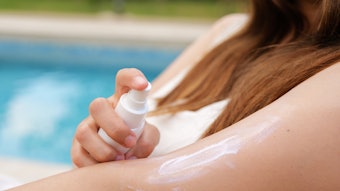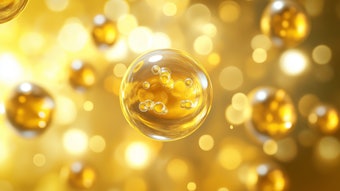On Aug. 27, 2007, the US Food and Drug Administration (FDA) published its long-awaited proposal to amend regulations governing sunscreens sold in the United States.1 In it, the FDA proposed new standards for formulating, testing and labeling OTC sunscreen drug products with UVA and UVB protection. For the first time, the FDA addressed the issue of sunscreen photostability and its importance to sunscreen performance:
“The FDA agrees that it is important to address the photostability for sunscreen drug product formulations. Unstable product formulations present the problem of degradation of product effectiveness during actual use,” the agency stated, adding, “The FDA is proposing to address photostability by adding a pre-irradiation step to the in vitro test method for measuring UVA protection."
With this pronouncement, the FDA put sunscreen marketers and formulators on notice that photostability is the foundation upon which future sunscreen products must be built.
So what is photostability and how does one lay a photostable foundation? What causes a sunscreen to lose photostability, and what, if anything, can a formulator do about it? Finding the answers to those questions has been the focus of research at HallStar for more than 10 years. The answers begin with some general background on the photophysics and photochemistry of UV filters.
Light and Electrons
Molecules that absorb energy from UV radiation (UVR) and visible light are called chromophores. Organic UV filters in sunscreens are chromophores and they convert the energy in UVR and light to electronic excitation energy.
Briefly, here’s how they work. Light is made up of packets of electromagnetic energy called photons that propagate through space at the rate of c, which is 3 x 1010 cm/sec in a vacuum or so-called light speed. Though they possess no charge themselves, photons generate electric and magnetic fields that oscillate between attraction and repulsion. In this way, photons exert a force on particles, such as electrons, that do have a charge.
The frequencies per second of these oscillations in UVR and visible light are of the same order as the frequencies that electrons oscillate in their atomic and molecular orbitals—roughly 1015 times per second.2 Under the right conditions, known as resonance, an electron in a molecule responds to this force by oscillating about the positively charged nuclear framework at a new, greater equilibrium distance and at a different angle to the nuclear axis.
Initially, the response involves only a change in the electron’s orbital and not a change to the electron’s other properties such as spin and phase; this is called the singlet excited state. The additional energy imparted to the electron by the photon is equal to the photon’s frequency, signified by the Greek letter ν, pronounced “nu,” times Plank’s Constant, 6.626 x 10-34, and signified in mathematical formulas by the letter h.3 The ultimate fate of the photo-absorbing molecule or chromophore is determined by the answer to one simple question: After excitation, where does the energy go?
Figure 1 is a graphical depiction of the processes by which chromophores dissipate their excited state energy. This model has been dubbed the rather whimsical name DEXSTERa, which stands for Deactivation of Excited States by Emissions and Radiationless pathways.
The circular structures on the DEXSTER model—those in blue, purple, and yellow—are reservoirs or manifolds that contain all the UV filter molecules in their various states: ground, singlet excited and triplet excited (see Excited States).
Imagine the blue ground state reservoir as containing all the UV filter molecules in the sunscreen applied to skin before it is exposed to the sun.
After it is exposed to sunlight, energy in the UV radiation “pumps” some of the ground state molecules in the sunscreen through the red pipe on the DEXSTER model’s left to the singlet excited state reservoir.
The green pipes depict the processes by which molecules in the excited state drain their energy and either move from the singlet excited state reservoir to the triplet excited state reservoir, or return directly from either excited state reservoir to the ground state.
The red faucet on the model’s right “leaks” molecules that are destroyed by photochemical reactions. As molecules are destroyed, there is a corresponding decline in the ground state reservoir.
Deactivation of a molecule’s excited state may take one of several pathways. For example, an electron energized by UV causes an electromagnetic disturbance in the space around it that may spawn yet another photon, though one of longer wavelength and lower energy than the original. If it does, the electron is immediately deactivated from its excited state and returns to its previously occupied, lower energy ground state.
The emission of a photon from the singlet excited state is called fluorescence, represented as F in the model. Later, fluorescence will be shown as a valuable tool that can be harnessed and used to discover paths to improve photostability. Emission of a photon from the triplet excited state is called phosphorescence or P on the model.
Fluorescence and phosphorescence are radiative processes because radiation is emitted in the form of a photon. Several other processes are radiationless. In one such process known as internal conversion, abbreviated as IC on the DEXSTER model, the electronic excitation energy is converted into kinetic energy—heat. Kinetic energy manifests in part as an increase in the magnitude and frequency of vibrations between atomic nuclei.
Another radiationless process is called intersystem crossing, in which the electron undergoes a change in spin or a shift in phase that is induced by a magnetic interaction called spin-orbit coupling.5 The electron settles for a period of time in another, somewhat lower-energy orbital about the nuclear framework. In this condition, known as a triplet excited state, the molecule may take on a diradical character that leaves it particularly vulnerable to destructive chemical processes suchas photoaddition/substitution reactions including hydrogen and electron abstractions, cycloadditons, isomerizations, and fragmentation reactions.6
Intersystem crossing appears on the DEXSTER model as ST when it takes place between the singlet and triplet excited states and as TS when between the triplet excited state and the ground state, which is in fact a singlet state.
Other pathways to excited state de-activation are of significant interest. One is energy transfer, in which the excited state energy of one molecule or the donor is transferred to another molecule, the acceptor. When this happens, the acceptor is said to have quenched the donor. Acceptors are also called quenchers. Most acceptors operate on the triplet excited state of donors. On the DEXSTER model, the triplet quenching pathway is abbreviated as TQ. Quenching of the singlet excited state, though relatively rare, also is possible and can be advantageous. On this model, the singlet quenching pathway is abbreviated as SQ.
Yet another possible deactivation pathway is through photochemical reaction, abbreviated as PCR on the model. Pathways leading to photochemical reactions are destructive to chromophores and produce chemicals that are distinctly different from the original chromophores.
If destroyed, chromophores are no longer available to absorb more photons.
This is the fundamental idea behind photostability—a photostable chromophore is one that is not destroyed during the process of deactivation and is, therefore, repeatedly available to absorb more photons. The fundamental goal in maintaining photostability, therefore, is to prevent the excited molecule from acquiring sufficient activation energy during its lifetime to react at a rate competitive with other modes of excited-state deactivation.7 This goal is accomplished by encouraging the excited molecule by some means to deactivate quickly and nondestructively.
Each unimolecular deactivation and reaction pathway is associated with a rate constant k, a lifetime τ and a quantum yield Ф. The lifetime is the reciprocal of the rate constant. So if the rate constant is a billion times per second, i.e., 109 sec-1, the lifetime is a billionth of a second, 10-9 sec.8 Quantum yield is the percentage of absorbed photons that leads to a particular pathway. So if, for example, out of 100 photons absorbed 20 molecules take the internal conversion pathway to deactivation, the quantum yield of internal conversion would be 0.20 or 20%.9
The rate at which a process actually proceeds is the product of the rate constant for that process and the concentration of the molecules that can undergo that process. When the rate constant is divided by the sum of all the rate constants of deactivation, one gets the relative efficiency of a particular deactivating pathway. Theoretically, all deactivation pathways compete with each other all the time. Those with the highest quantum yields and fastest rates predominate.
Under normal operating conditions such as at room temperature (25°C) or skin temperature (37°C), increasing the concentration of acceptor molecules or quenchers increases the observed rate of energy transfer. As the quantum yield of quenching increases, the quantum yields of potentially destructive processes to the donor are reduced.
Excited State Quenching
The term quenching may be applied to any process that deactivates a molecule in an excited state. However, in this context, quenching means deactivation by a particular set of processes known as energy transfer. As mentioned previously, a donor molecule in an excited state can, under certain conditions, transfer its excited state energy to a nearby acceptor molecule. The donor returns to the ground state and the acceptor is elevated to an excited state. The acceptor then dissipates its excited state energy and returns to the ground state.
Two mechanisms account for energy transfer of this type. The first is the induced dipole or Coulombic interaction, which is analogous to a transmitter-antenna mechanism. The oscillating excited electron of the donor generates an electromagnetic field that in turn excites one of the acceptor’s electrons to a higher energy orbital. This action occurs at a distance, although it diminishes in force with the inverse sixth power of the distance between the donor and acceptor molecule.10
The second way energy is transferred is by a collisional or exchange mechanism. Here, the donor and acceptor molecules are close enough that their electron clouds overlap, permitting an exchange of excited electron from the donor and ground state electron from the acceptor.11
Usually, this exchange takes place when the donor is in the triplet excited state. After the exchange takes place, the donor returns to the ground state and the acceptor is elevated to the triplet excited state. This is known as triplet-triplet energy transfer.
Both the Coulombic and exchange mechanisms may be in operation when the donor is in the singlet excited state; only the exchange mechanism operates when the donor is in the triplet excited state.12
Triplet-triplet energy transfer by the exchange mechanism is by far the most common energy transfer mechanism encountered in organic photochemistry in general13 and in sunscreen systems in particular. All the commonly used sunscreen photostabilizers—octocrylene, methylbenzylidene camphor, diethylhexyl 2,6-naphthalate and a recently introduced polyester-8 and photostabilizing silicone fluid (PSF) (see Figure 2)—are acceptors of triplet excited state energy.14 They are designed so that the triplet excited state of a photo-unstable donor can be quenched before destructive photochemical reactions can occur. Figure 3 depicts this process.
Singlet quenching is also possible and may offer some important advantages. For example, quenching a chromophore while it is still in its singlet excited state will reduce the population of triplet excited state molecules, from which most destructive photochemical reactions originate. In addition, the quenched chromophore will be available to absorb another photon much sooner. Figure 4 shows that quenching the singlet excited state preempts population of the triplet excited state by intersystem crossing.
The theories for energy transfer developed by Förster, i.e., Coulombic mechanism, and Dexter,1 exchange mechanism, relate the rates at which energy transfer proceeds from donor in the singlet excited state to acceptor to a quantity called the spectral overlap integral.15 The magnitude of the spectral overlap integral in turn is related to the probability that donor and acceptor are energetically compatible.16
The spectral overlap integral is simply the area of overlap on a graph between the fluorescence emission spectrum of the donor and the absorption spectrum of the acceptor. In Figure 5a–d, the absorption and emissions spectra are shown for donor/acceptor pairs avobenzone/oxybenzone, a small overlap; octinoxate/octocrylene, a large overlap; avobenzone/octocrylene, no overlap; and avobenzone/ethylhexyl methoxycrylene, a large overlap.
As a general note, both Förster’s and Dexter’s theories state that the greater the overlap, the higher the rate of energy transfer. The difference between the two theories in this regard is that Förster’s theory says the magnitude of the extinction coefficient is important, whereas Dexter’s theory says it is not.17 There is good support for the Forster and Dexter theories in the fluorescence quenching experiments, as will be described later.
Learning from Fluorescence
Nature provides us with a convenient tool for measuring singlet quenching. It is fluorescence, the emission of a photon from the singlet excited state. Emissions between approximately 400 nm and 800 nm are visible to the human eye; those less than 400 nm and greater than 800 nm may be read by instruments.
When a compound can be made to fluoresce under UVR, many of its photophysical properties are more easily studied. For example it is possible, using a specially outfitted spectrofluorometer, an instrument that measures fluorescent emissions, to discern the decay curve of fluorescence and therefore its lifetime in nanoseconds. This in turn provides insight into the probability of quenching by Coulombic, exchange or other mechanisms. Using the same instrument, one may plot the fluorescent intensity of a compound as a function of the concentration of a potential quencher. Such a plot is known as a Stern-Volmer analysis and provides vital information either when designing or attempting to avoid photochemical reactions.
In the sunscreen realm, chemists obviously are trying to avoid photochemical reactions, so the objective is either to quench excited triplets before they can photochemically react, or to quench excited singlets before they can intersystem cross to triplets. Lately, this author’s research has focused on the latter strategy and a method based on visible fluorescence has been developed to help make progress in that direction.
Figure 6 shows the visible fluorescence of avobenzone and octinoxate, respectively. Note that while most of octinoxate’s emissions are below 400 nm and therefore invisible to the human eye, enough of the emissions extend into the visible range to provide a useful visual signal.
The new fluorescence method is simple and employs standard laboratory equipment and supplies. Briefly, solutions of the tested UV filter were made in a volatile solvent, in this case ethyl acetate. A photochemically inert compound—phenethyl benzoate in this test—was added in graduated amounts to two solutions; the test compound/potential quencher was added in identical graduated amounts by weight to two more solutions. A small drop of each solution was applied using a micropipette in two rows of three spots each to a TLC plate. The first spot on the left of each row represents the UV filter solution with nothing added (see Figure 7).
On the top row, the next two spots represent the solutions with graduated amounts of the test compound. On the bottom row, the next two spots represent the solutions with graduated amounts of the photochemically inert compound. These were the negative controls.
The spots were allowed to dry on the TLC plate. As the volatile solvent evaporates, the solutes—the UV filter and other compound—are immobilized in the silica matrix of the TLC plate. This creates a situation analogous to freezing an organic solution of a chromophore to an optically clear glass; bimolecular quenching and photochemical reactions are minimized and emissions from the singlet excited state are optimized.18 In such a situation, the effect on the UV filter’s fluorescence of the co-solute is easily seen.
To read the results, first look for signs of concentration dependence. For example, along the top row, is the middle spot darker than the one to its left? And is the spot on the right darker than the middle one? Then, look for signs of quenching. Is the top middle spot darker than the one immediately below it? Is the top right spot darker than the one immediately below it? When the quenching is strong, the top right spot is virtually black.
The structures of the compounds tested by this method appear in Figure 8. The results are depicted in Figure 7.
Briefly: oxybenzone quenches avobenzone weakly; octocrylene quenches octinoxate strongly; octocrylene does not quench avobenzone; and ethylhexyl methoxycrylene quenches avobenzone strongly. These simple experiments shed new light on two sunscreen mysteries commonly encountered by formulators.
For example, many formulators have noticed that adding oxybenzone to a formulation containing avobenzone helps the formulation’s photostability. Some have suggested that oxybenzone acts as a sunscreen for avobenzone, essentially protecting the avobenzone from certain presumably destructive wavelengths of UVR. If true, this proposal would repudiate Beer’s Law, a fundamental physical principle that states that the absorbance of a solution is proportional to the chromophore concentration and the path lengthb. Therefore, adding to the chromophore concentration, whether by adding the same or different species, simply increases the absorbance of the solution.
So, what is the truth? The most likely possibility is that there is some form of photophysical interaction between the chromophore species and a likely place to look is excited state quenching.
Easily seen in Figure 7a, oxybenzone shows both concentration dependence and quenching of avobenzone fluorescence. The effect is relatively weak but it is there and it provides a partial, if not complete, explanation for the observations depicted in Figure 9, which demonstrates increased photostability of an avobenzone sunscreen when oxybenzone is added to it.
Another example of an observed sunscreen mystery is that octocrylene is a powerful photostabilizer for avobenzone in the absence of octinoxate. As countless formulators have discovered over the years, adding octinoxate to the formulation causes it to lose photostability, resulting in missed SPF targets, and in light of the new FDA proposed rules, making UVA protection targets nearly unobtainable.
So, what is happening? Figure 10 depicts one possible explanation—a photochemical reaction between octinoxate and avobenzone.
Figure 11 shows the practical consequence: upon exposure to UVR, the sunscreen loses absorbance in both the UVB and UVA regions.
Consider an example of a strong fluorescence quencher. Figure 7b shows octocrylene’s ability to quench the fluorescence of octinoxate and the effect is quite strong. Ironically, as Figure 7c shows, octocrylene does not quench avobenzone’s fluorescence at all. Consequently, adding a lot of octocrylene to an avobenzone-octinoxate formulation does a good job of photostabilizing the octinoxate, but not the avobenzone. This is illustrated in Figure 12, showing the photostability of a formulation containing 5% octinoxate, 2% avobenzone and 8.8% octocrylene before and after irradiation with 35 MED.
Presumably, the process with the faster rate, the quenching of octinoxate fluorescence, is occurring at the expense of the process with the slower rate, the quenching of avobenzone triplets.
The lifetime of the singlet excited state (10-7-10-11 sec) is typically several orders of magnitude shorter than the lifetime of the triplet excited state (10-3-10-7 sec) of the same chromophore.19 The observation that a process is competitive with fluorescence, i.e., quenches the emission from the singlet excited state, is good evidence that the process is effectively deactivating the excited chromophore before downstream processes such as intersystem crossing to the triplet reservoir and therefore photochemical reactions can occur.20
Such is the evidence provided by Figure 7d, which shows that ethylhexyl methoxycrylene is an effective quencher of avobenzone fluorescence. A similar result (not shown) is observed when ethylhexyl methoxycrylene is added to octinoxate. These observations lead to the prediction that adding ethylhexyl methoxycrylene or other methoxycrylene derivatives to a sunscreen formulation containing both octinoxate and avobenzone just might photostabilize both UV filters. As shown in Figure 13, that is exactly what happens: A formulation containing 5% octinoxate and 2% avobenzone is photostabilized by 7% ethylhexyl methoxycrylene.
A sample of this formulation was tested on five human subjects for UVA protection by the Japanese (JCIA) method and achieved a UVA protection factor score of 13.79. The FDA’s recently proposed rules set 12 as the minimum for the highest 4-star rating of UVA protection, a level of protection heretofore difficult to achieve by means available in the United States.
Conclusion
The FDA has set the bar high for US sunscreen manufacturers by redefining what it means to be protected from the harmful effects of the sun. The proposed new rules require manufacturers to fully disclose how well their products protect against UVB, the radiation primarily responsible for sunburn, and UVA, whose effects are less well understood but nevertheless associated with numerous threats to appearance and health.
Over time, the new rules, if adopted, will lead to better educated and more demanding consumers of sun protection products. Living up to their expectations poses new challenges for formulators because, even if amended as the FDA proposes, the monograph for sunscreen drug products contains no new tools for achieving the levels of UVA protection required to obtain the highest rating. The FDA acknowledged this in remarks accompanying the proposed rules:
“The FDA is aware of the difficulty for current sunscreen formulations to meet the ‘highest’ category and believes that allowing such a category will foster additional research and development in this area.”21
If that statement seems prescient in light of the science and technologies discussed in this article, perhaps it is because anticipation of the new rules has, in fact, fostered that additional research and development the FDA believed would happen. The science is based on an understanding of the processes, or pathways, an excited molecule takes to return to the ground state or, undesirably, to a destructive photochemical reaction. New photostabilizing technology flows from that understanding, just as better health will surely flow from the added protection afforded by photostable sun protection products.
Acknowledgements: The author gratefully acknowledges the support, and encouragement of Anna Pavlovic, Jean Zhang, Steve Semlow, Bill Bausback, Victor Zubb, David Cromley, Gary Wentworth and John Paro, all of The Hallstar Co.; also Tony O’Lenick and Louis Paul of SolaSil Inc.
References
- Proposed Rules, US Food and Drug Administration Web site, Available at: www.fda.gov/OHRMS/DOCKETS/98fr/07-4131.pdf; also Federal Register v 72 No. 165 (Aug 27, 2007)
- NJ Turro, Modern Molecular Photochemistry, Menlo Park, CA USA: Benjamin/Cummings (1978) p 8
- Ibid ref 2 pp 78–81
- NJ Turro, Modern Molecular Photochemistry, Menlo Park, CA USA: Benjamin/Cummings (1978) p 23
- Ibid ref 2, p 48
- Ibid ref 2, pp 215–224, 264–265 and 417–432
- Ibid ref 2, p 235
- Ibid ref 2, p 89
- Ibid ref 2, pp 109, 110
- Ibid ref 2, pp 299–305
- Ibid ref 2, pp 305–309
- Ibid ref 2, p 329
- Ibid ref 2, p 329
- NA Shaath, The Encyclopedia of Ultraviolet Filters, Carol Stream, IL USA: Allured (2007) p19
- NJ Turro, Modern Molecular Photochemistry, Menlo Park, CA USA: Benjamin/Cummings (1978) pp 303,305
- Ibid ref 2, pp 310–311
- Ibid ref 2, pp 303, 305
- Ibid ref 2, p 109
- Ibid ref 2, p 352
- Ibid ref 2, p 109
- Proposed Rules, US Food and Drug Administration Web site, available at: www.fda.gov/OHRMS/DOCKETS/98fr/07–4131.pdf; also Federal Register v 72 No. 165 (Aug 27, 2007)










